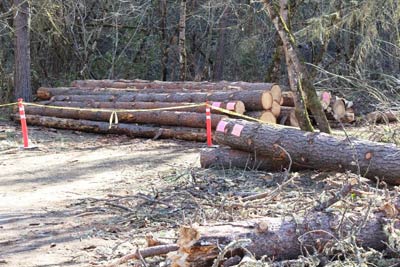Trail Talk – May 2015
Those of you who walk in the Woodlands, specifically the Sarah Zigler trail, no doubt saw the decks of logs at the far end near the parking lot last month. Those trees were damaged by the Western Pine Beetle (WPB), an insect that unfortunately infests pine forests across 10 western states.
The Western Pine Beetle (Dendroctonus brevicomis) is a small critter approximately 3-5 mm in length, brownish-black in color, and cylindrical in shape that attacks trees that are under water stress. Root rot infections may predispose trees to water stress during drought, which we were under last year. Beetles selectively attack trees that have been weakened by drought, lightning strikes, or other agents that interfere with the water balance of the tree.
After a tree is attacked by these insects, wherein mating takes place, the female lays her 60 +/- tiny pearl-white eggs individually in niches, or tunnels. To make a long story short, the whole life cycle of this insect takes place within the inner layers of the bark, where larval stages do most of the damage.
The larvae are small white grubs that feed first in the phloem, where they construct a short gallery. They then mine into the middle bark where most of their development takes place. After completing four larval stages, they transform into pupae and then into adults. As these brood adults feed on the middle and outer bark, fungal spores collect on their heads. As they continue to bore, the fungus is passed throughout the tree. The fungus eventually blocks the conductive vessels of the inner bark and sapwood. Once the vessels are blocked, the foliage begins to fade, first to a pale green, then to yellow, straw, and sorrel. Finally, perhaps after a year, the foliage may turn reddish-brown. This fading is the first evidence of damage to the tree that is visible at a distance.
The City of Jacksonville, and the Jacksonville Woodlands Association (JWA), with the assistance of entomologists and foresters, will be studying our adjacent forests in the near future, and may be recommending a tree removal prescription plan to stem the further infestation by these beetles. This is not a prescription that is taken lightly, as some of the trees targeted for removal were just seedlings when Peter Britt was here! Progress in this endeavor will be made public at a future date.
Note: Stressed pine trees will show clumps of yellow or red needles. Stressed trees don’t necessarily harbor WPB, but they might. Keeping an eye on these trees for signs of infestation is critical. Getting rid of the tree as soon as you identify that it is infested is highly recommended. Nearby pine trees on your property and your neighbors WILL VERY LIKELY become infested if the tree and all of its bark is left on your property.

 Trail Talk is a monthly column by Tony Hess, Gary Sprague & Bob Budesa about hiking the Jacksonville Woodlands trail system. For more information, please visit the Jacksonville Woodlands Association website at
Trail Talk is a monthly column by Tony Hess, Gary Sprague & Bob Budesa about hiking the Jacksonville Woodlands trail system. For more information, please visit the Jacksonville Woodlands Association website at